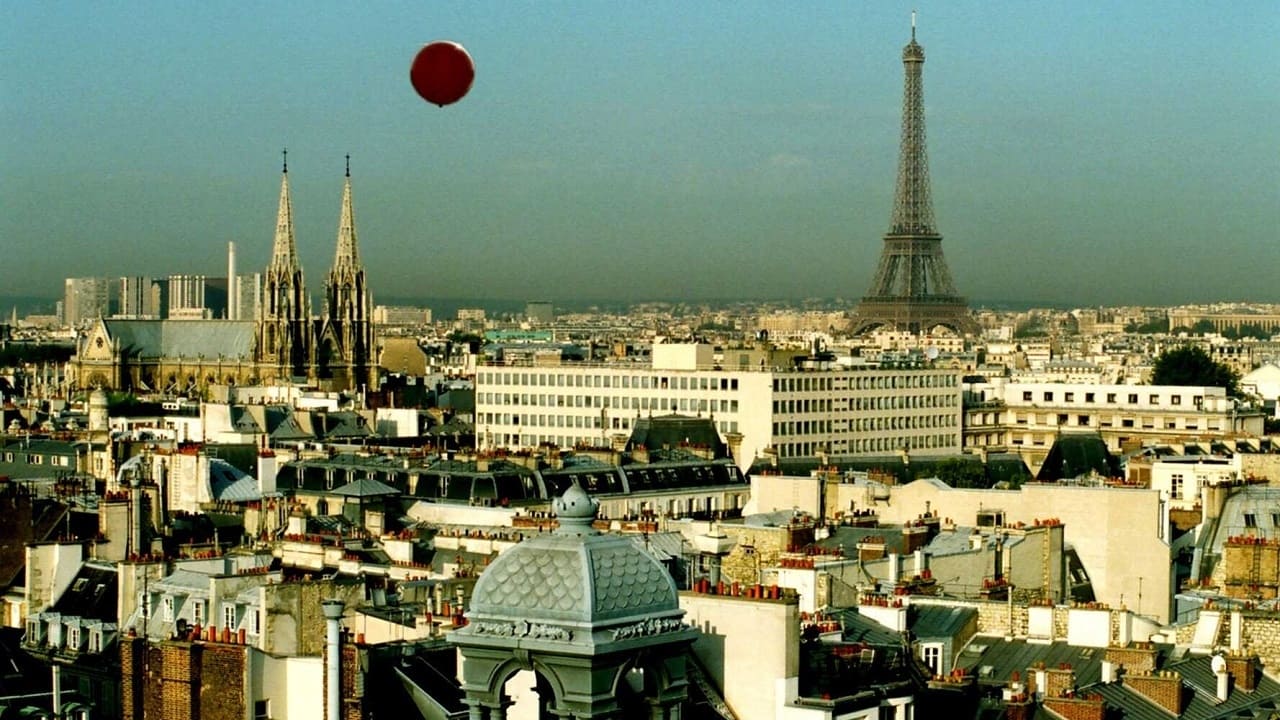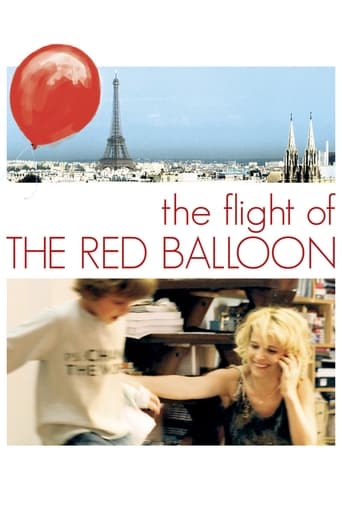



A movie that not only functions as a solid scarefest but a razor-sharp satire.
View MoreI didn’t really have many expectations going into the movie (good or bad), but I actually really enjoyed it. I really liked the characters and the banter between them.
View MoreA great movie, one of the best of this year. There was a bit of confusion at one point in the plot, but nothing serious.
View MoreYes, absolutely, there is fun to be had, as well as many, many things to go boom, all amid an atmospheric urban jungle.
View MoreThis morning when I looked at "The Flight of the Red Balloon" lying on our bistro table waiting to share its journey with me, I realized that I had been avoiding watching it because of how much I love Albert Lamorisse's Red Balloon from 1956. I would like to believe that it's a staple of every household (not just French), every language and art teacher's classroom, and a necessity for anyone who dares to let loose their imagination and dreams.The first scene itself grabbed me with young Simon talking to a red balloon outside the subway entrance, so I settled down and let myself enjoy the rest. It spread a warmth inside me like when soft morning sunlight streams in through closed windows--all is lit, quiet, still, warm, and happy--oblivious of that which might have transpired the day before, lovingly inviting you to a fresh and a new beginning full of possibility.Hou Hsiao Hsien, the 60-year-old born-in-China-raised-in-Taiwan filmmaker, packs in so much and with such adroitness that he makes everything seem simple.The broader context of the film is dark -- frankly, realist -- a single mom, Suzanne, juggling work and care for her children (one of whom is away at school). In her struggle Suzanne races to get it to it all but winds up diluting the quality time she would spend with her 7- year old, Simon, were she not so devoted to her career in puppetry and theater (Juliette Binoche is brilliant as she gives voice to the puppets).The child minder she hires is a Taiwanese film student, Song, who is quiet and aloof in her own way, her attention divided between taking care of Simon's needs and making progress on her film making project--a tribute to Lamorisse's Red Balloon.Simon is self-absorbed as well. He moves from one thing to another, seamlessly, propelled by instinct and sub-consciously felt needs and desires, just as a boy his age would. We watch him practice piano, play on his Playstation, go for long walks in town with Song, speak to the red balloon, talk on the telephone, use the digital movie camera to help Song make her film, and register the adult world conflict and strife albeit peripherally.Three different worlds and levels of consciousness and isolation. Yet, no one seems to make undue demands of one another and everyone seems to try to accommodate others' needs, and in doing so they spin a delicate web of verbal and mostly non-verbal communication-- facial expressions, body language, decor, and silence--as they meet the challenges of modern day living. Hou is able to find the reassuring simplicity in this complex world, and that's what tempers the dark hues and keeps the spirits high.Explaining in an interview with Mathieu Menossi of événe.fr (January 2008) why he chose to re-make Lamorisse's film, Hou says, --and I translate this from French -- It's been fifty years since the original Red Balloon came out, but for me it persists like an old spirit. A soul that did not depart but continued on it's journey to contemplate our current world. (my translation)Hou also says, --again, my translation -- The red balloon represents what resides in all of us in the form of childhood sensibilities and instinct and passion. And from my point of view, the red balloon is me, as the director.The red balloon seems to watch over and observe everyone at play from a distance. It tells us that hope and color survive in adverse circumstances. While it does not interact with the characters in this story--save the very first scene--it does interact with us, the spectators, and has been placed there for us. The red balloon IS us, silently bobbing along, hovering, eavesdropping... It's Hou reminding us that we, too, can be playful and buoyant , rising above the vicissitudes of life that seem to tie us down. And since the balloon is silent, we can supply our own dialog as needed to complete our own story of the "flight." Ironically, but happily, we are captives of Hou's machinations.Hou did not try re-make the same film. He paid homage to the original film by making another beautiful film, symbolically related to its predecessor. And in doing so, he also forced us to ask the question about the place and influence art has in our lives today. This is also a nod to music (piano lessons), painting (Félix Valloton's tableau in the Musée d'Orsay), oral folk traditions (the revival of puppetry as a valid and precious art form of its own), and of course the 7th art (Song making a film using her digital movie camera to pay homage to Lamorisse). The inter-textuality and the mingling of different cultures is particularly elegant and appropriate given the times we live in today.Using the opposition between dark and light, banality and magic, pragmatism and innocence, adulthood and childhood, just like in Félix Vallonton's "le ballon" from 1899, Hou has created a masterpiece that offers layers of color and texture to the viewer with a patient eye.
View MoreHou Hsaio Hsien's "The Flight of the Red Balloon" is a tribute of sorts to 1956's "The Red Balloon," probably the most well known and widely seen short film of all time. That movie told the simple but lyrical tale of a young boy who is followed around the streets of Paris by a helium-filled balloon that seems to have a life and mind of its own. But if you go into this new film expecting anything close to a remake of the first one, you will be supremely disappointed."The Flight of the Red Balloon" is also set in Paris and it does feature a balloon and a boy - but that's about as far as the comparisons go between the two movies. What "The Flight of the Red Balloon" fails to capture is that special spirit of wonder, magic and imagination that has so enchanted "Red Balloon" aficionados for generations. Instead, we're stuck with a mind-numbingly tedious story involving a single mother (Juliette Binoche), her somewhat soporific son (Simon Iteanu), and a Chinese filmmaker (Fang Song) who serves as the boy's nanny and who wants to make a movie of her own modeled after "The Red Balloon." For long stretches of time, the title character doesn't even appear in the film, and you may find yourself wanting to holler "Bring on the balloon!" every time these self-absorbed characters launch into yet another of their eternal gabfests. In fact, when the balloon does make one of its infrequent appearances, all it does is hover around the edges of the scene to no discernible point or purpose. Too bad these nonstop blatherers didn't yield more of their screen time to the balloon.
View MoreAt first I was surprised to see such a negative first review. After looking through the other comments I understood why. There is no middle impression on this movie. It's one of those movies that you love or hate/dislike. It's not a "good" or "not bad" movie.I just think it touched some people, like me. I spent 1 1/2 years in Paris and I have a profound passion for French culture since I was a kid. For me, after living for more than 5 months in China, it felt good to remember Paris. I saw a movie that depicted only a snapshot of some people's lives. Their way of living, their problems are typical to the French society.One user was talking about plot, drama. For me, this movie was more about feelings than actions. Some smiles, some tears, the image, the people. It made me remember "Paris, je t'aime".I think that if I didn't have the Paris experience or an affinity for the French society, the movie wouldn't have touched so much. I think there's a second level in this movie that is accessible only to those who understand the French society.
View MoreArt of a very high order, Hsiao-hsein Hao directs the Musee d'Orsay commissioned "The Flight of the Red Balloon", a stand-alone film paying homage to the Lamorisse's 1956 film favorite "The Red Balloon". Directed with class and elegance, although stumbles in indulgent overextended shots and pacing problems, it pays dividends to the patient as we are welcomed into a claustrophobic apartment inhabited by a mother and son struggling to come to grips with a marital separation. The film knows its audience and it caters to them loyally, however won't convert any non-believers.Although not explicit, the sense of chaos is however present right from the point where we enter Suzanne and Simon's apartment in Paris. Clearly not in control of her marital and maternal situation, she drowns herself in work as a puppet show narrator where she can control the fantastic as opposed to her real and disorganized state. Enter Song, a film student who acts as Simon's surrogate as his mother deals with this transitional process.The film's screenplay is as light as a helium balloon, we enter their micro-cosmos through Song, almost this film's allegory towards the original's red balloon as its voyeuristic anchor nonjudgmental and omnipresent. Although certain scenes clearly leads to nowhere, they are nonetheless welcome as it highlights the reality of the situation and also the characters' desire to reach back to normal. It is clear here, Suzanne desires a somewhat 'normal' family life: almost pleading for her eldest daughter to move back to Paris and for his ex-husband's friend/tenant to leave the property. A daughter of divorce, she knows it is imperative that a routine has to be established.The way Hao films this, it has this odd certain detachment towards the characters, almost a "Wings of Desire" approach, static camera in tow. We see a single mother in despair but the audience isn't allowed to feel anything about it: almost factual. Binoche personifies Suzanne with a quiet dignity and pride that her devastation is disallowed to be brought to the surface, but of course, when things build up to a boil, we can sense her immediate discomfort and frustration.What seems like a nonchalant Simon, he is clearly affected too, as he can't even distinguish his own family tree, to the effect that even the audience can be driven to confusion. He becomes distant to his own mother, finding solace through nostalgia with a long summer with his sister. He and Suzanne's relationship is also obviously affected, as most of the film, they indulge in small talk and when the mother desires for an eye to eye contact, he looks away.The decision to film this in a calming atmosphere as opposed to the chaos in the characters' is a smart idea: it highlights the juxtaposition even more. As opposed to the Lamorisse classic, the maternal figure here is in focus. The film works within its parameters and Hao does not belittle its audience of course, only to those willing to be engulfed by it.
View More